Facilitating Changes in Health and Social Care
VerifiedAdded on 2023/04/04
|11
|2737
|288
AI Summary
This report discusses the factors that facilitate changes in health and social care services and settings. It explores the impact of recent changes and the appropriate service response. It also covers the principles of change management and the planning and monitoring of changes in health and social care.
Contribute Materials
Your contribution can guide someone’s learning journey. Share your
documents today.

Facilitating Changes in
Health and Social Care
Health and Social Care
Secure Best Marks with AI Grader
Need help grading? Try our AI Grader for instant feedback on your assignments.
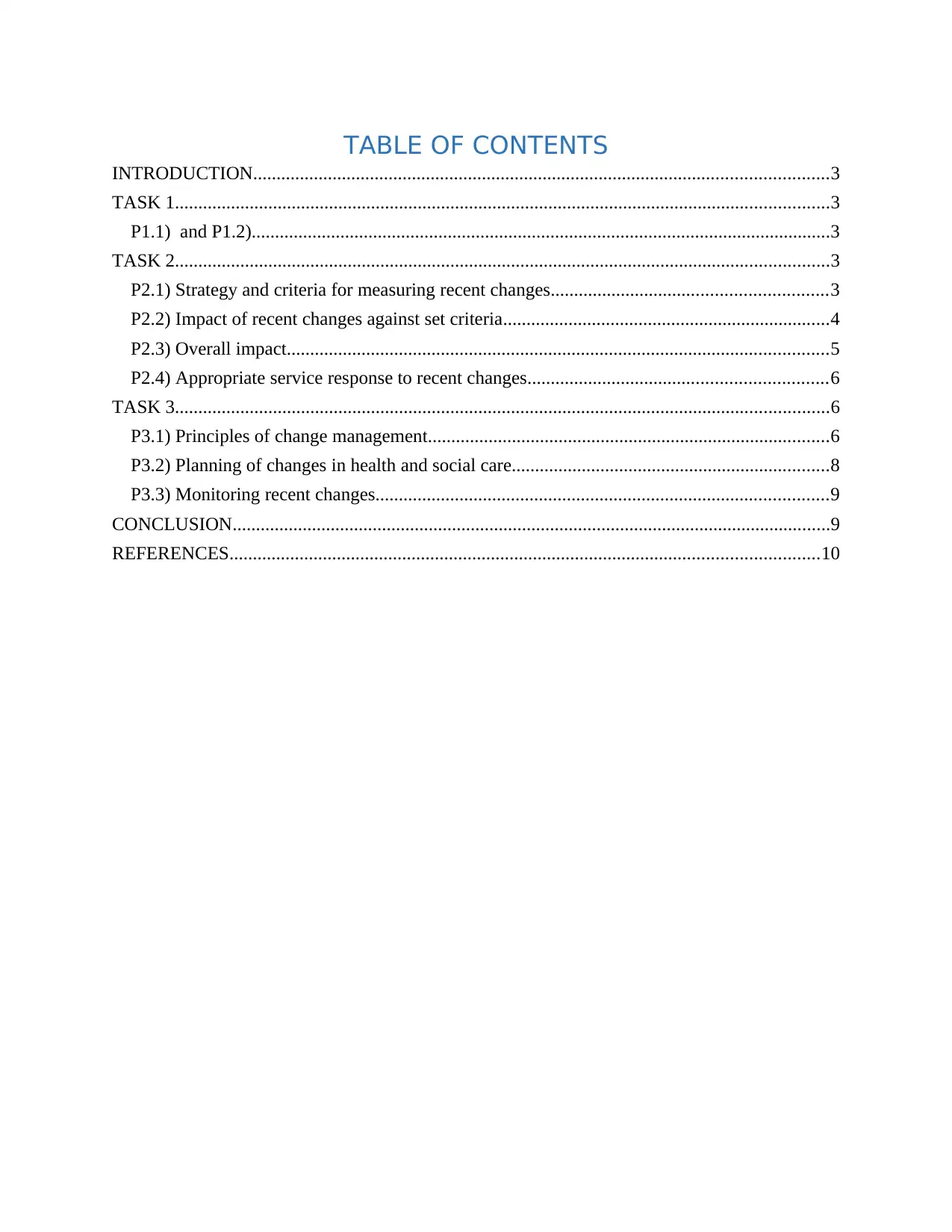
TABLE OF CONTENTS
INTRODUCTION...........................................................................................................................3
TASK 1............................................................................................................................................3
P1.1) and P1.2)............................................................................................................................3
TASK 2............................................................................................................................................3
P2.1) Strategy and criteria for measuring recent changes...........................................................3
P2.2) Impact of recent changes against set criteria......................................................................4
P2.3) Overall impact....................................................................................................................5
P2.4) Appropriate service response to recent changes................................................................6
TASK 3............................................................................................................................................6
P3.1) Principles of change management......................................................................................6
P3.2) Planning of changes in health and social care....................................................................8
P3.3) Monitoring recent changes.................................................................................................9
CONCLUSION................................................................................................................................9
REFERENCES..............................................................................................................................10
INTRODUCTION...........................................................................................................................3
TASK 1............................................................................................................................................3
P1.1) and P1.2)............................................................................................................................3
TASK 2............................................................................................................................................3
P2.1) Strategy and criteria for measuring recent changes...........................................................3
P2.2) Impact of recent changes against set criteria......................................................................4
P2.3) Overall impact....................................................................................................................5
P2.4) Appropriate service response to recent changes................................................................6
TASK 3............................................................................................................................................6
P3.1) Principles of change management......................................................................................6
P3.2) Planning of changes in health and social care....................................................................8
P3.3) Monitoring recent changes.................................................................................................9
CONCLUSION................................................................................................................................9
REFERENCES..............................................................................................................................10
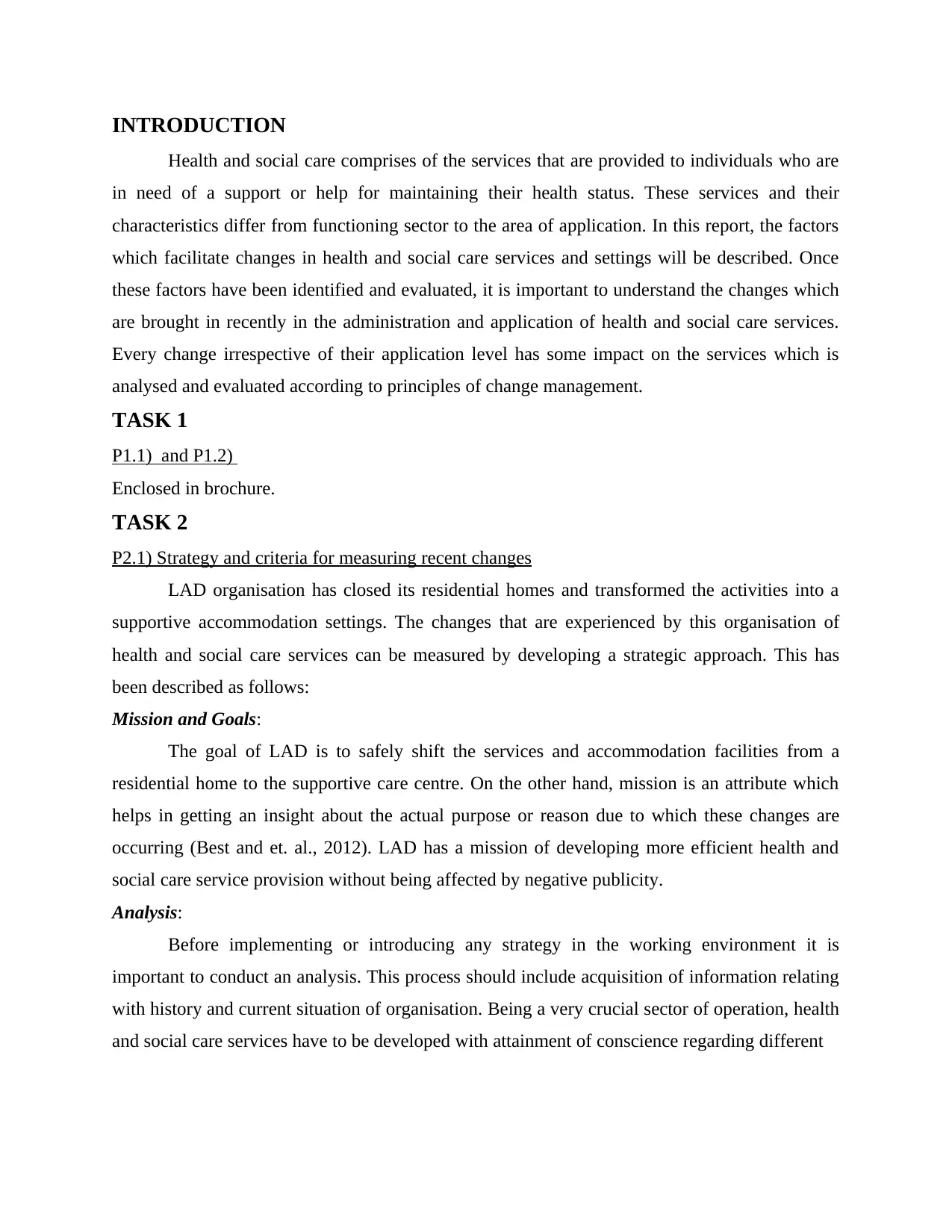
INTRODUCTION
Health and social care comprises of the services that are provided to individuals who are
in need of a support or help for maintaining their health status. These services and their
characteristics differ from functioning sector to the area of application. In this report, the factors
which facilitate changes in health and social care services and settings will be described. Once
these factors have been identified and evaluated, it is important to understand the changes which
are brought in recently in the administration and application of health and social care services.
Every change irrespective of their application level has some impact on the services which is
analysed and evaluated according to principles of change management.
TASK 1
P1.1) and P1.2)
Enclosed in brochure.
TASK 2
P2.1) Strategy and criteria for measuring recent changes
LAD organisation has closed its residential homes and transformed the activities into a
supportive accommodation settings. The changes that are experienced by this organisation of
health and social care services can be measured by developing a strategic approach. This has
been described as follows:
Mission and Goals:
The goal of LAD is to safely shift the services and accommodation facilities from a
residential home to the supportive care centre. On the other hand, mission is an attribute which
helps in getting an insight about the actual purpose or reason due to which these changes are
occurring (Best and et. al., 2012). LAD has a mission of developing more efficient health and
social care service provision without being affected by negative publicity.
Analysis:
Before implementing or introducing any strategy in the working environment it is
important to conduct an analysis. This process should include acquisition of information relating
with history and current situation of organisation. Being a very crucial sector of operation, health
and social care services have to be developed with attainment of conscience regarding different
Health and social care comprises of the services that are provided to individuals who are
in need of a support or help for maintaining their health status. These services and their
characteristics differ from functioning sector to the area of application. In this report, the factors
which facilitate changes in health and social care services and settings will be described. Once
these factors have been identified and evaluated, it is important to understand the changes which
are brought in recently in the administration and application of health and social care services.
Every change irrespective of their application level has some impact on the services which is
analysed and evaluated according to principles of change management.
TASK 1
P1.1) and P1.2)
Enclosed in brochure.
TASK 2
P2.1) Strategy and criteria for measuring recent changes
LAD organisation has closed its residential homes and transformed the activities into a
supportive accommodation settings. The changes that are experienced by this organisation of
health and social care services can be measured by developing a strategic approach. This has
been described as follows:
Mission and Goals:
The goal of LAD is to safely shift the services and accommodation facilities from a
residential home to the supportive care centre. On the other hand, mission is an attribute which
helps in getting an insight about the actual purpose or reason due to which these changes are
occurring (Best and et. al., 2012). LAD has a mission of developing more efficient health and
social care service provision without being affected by negative publicity.
Analysis:
Before implementing or introducing any strategy in the working environment it is
important to conduct an analysis. This process should include acquisition of information relating
with history and current situation of organisation. Being a very crucial sector of operation, health
and social care services have to be developed with attainment of conscience regarding different
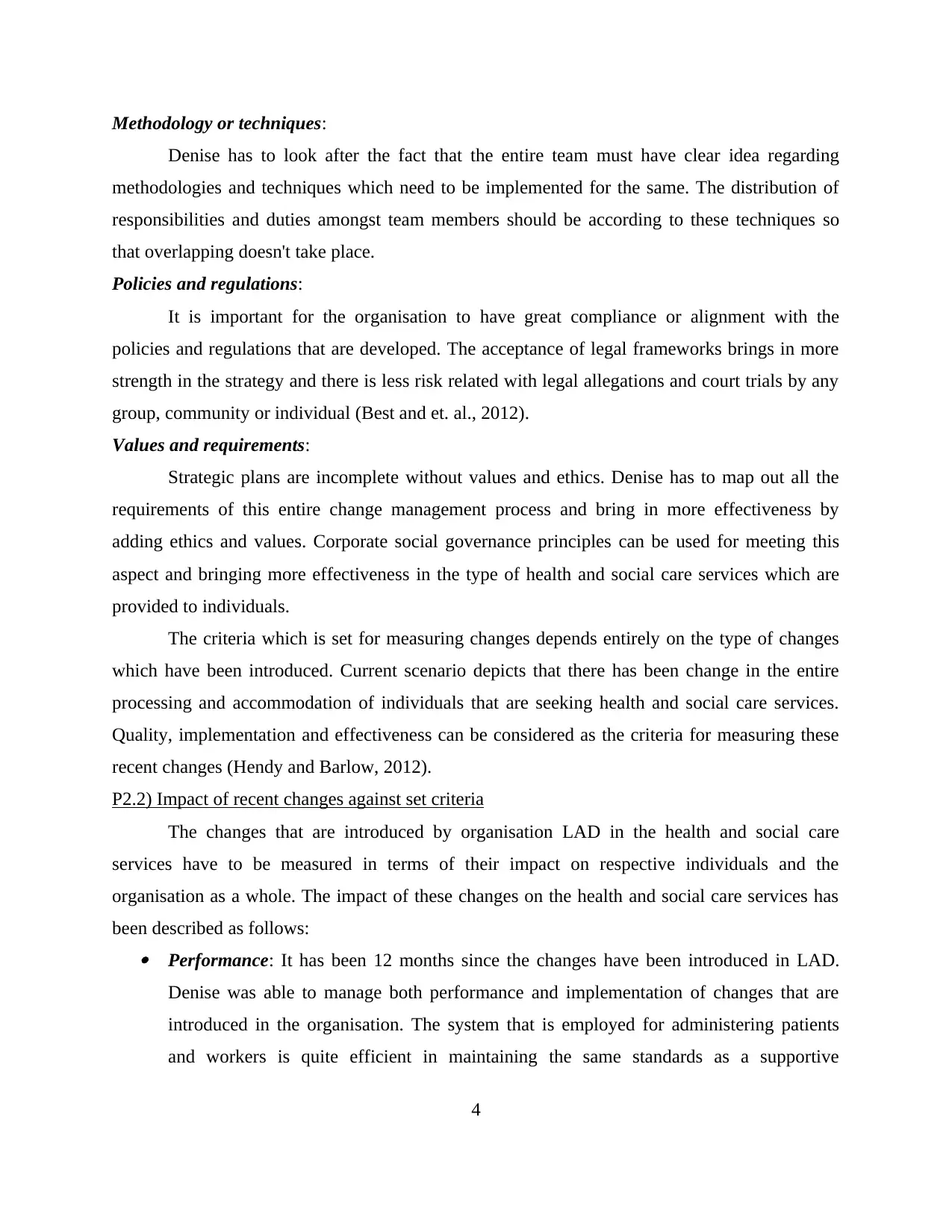
Methodology or techniques:
Denise has to look after the fact that the entire team must have clear idea regarding
methodologies and techniques which need to be implemented for the same. The distribution of
responsibilities and duties amongst team members should be according to these techniques so
that overlapping doesn't take place.
Policies and regulations:
It is important for the organisation to have great compliance or alignment with the
policies and regulations that are developed. The acceptance of legal frameworks brings in more
strength in the strategy and there is less risk related with legal allegations and court trials by any
group, community or individual (Best and et. al., 2012).
Values and requirements:
Strategic plans are incomplete without values and ethics. Denise has to map out all the
requirements of this entire change management process and bring in more effectiveness by
adding ethics and values. Corporate social governance principles can be used for meeting this
aspect and bringing more effectiveness in the type of health and social care services which are
provided to individuals.
The criteria which is set for measuring changes depends entirely on the type of changes
which have been introduced. Current scenario depicts that there has been change in the entire
processing and accommodation of individuals that are seeking health and social care services.
Quality, implementation and effectiveness can be considered as the criteria for measuring these
recent changes (Hendy and Barlow, 2012).
P2.2) Impact of recent changes against set criteria
The changes that are introduced by organisation LAD in the health and social care
services have to be measured in terms of their impact on respective individuals and the
organisation as a whole. The impact of these changes on the health and social care services has
been described as follows: Performance: It has been 12 months since the changes have been introduced in LAD.
Denise was able to manage both performance and implementation of changes that are
introduced in the organisation. The system that is employed for administering patients
and workers is quite efficient in maintaining the same standards as a supportive
4
Denise has to look after the fact that the entire team must have clear idea regarding
methodologies and techniques which need to be implemented for the same. The distribution of
responsibilities and duties amongst team members should be according to these techniques so
that overlapping doesn't take place.
Policies and regulations:
It is important for the organisation to have great compliance or alignment with the
policies and regulations that are developed. The acceptance of legal frameworks brings in more
strength in the strategy and there is less risk related with legal allegations and court trials by any
group, community or individual (Best and et. al., 2012).
Values and requirements:
Strategic plans are incomplete without values and ethics. Denise has to map out all the
requirements of this entire change management process and bring in more effectiveness by
adding ethics and values. Corporate social governance principles can be used for meeting this
aspect and bringing more effectiveness in the type of health and social care services which are
provided to individuals.
The criteria which is set for measuring changes depends entirely on the type of changes
which have been introduced. Current scenario depicts that there has been change in the entire
processing and accommodation of individuals that are seeking health and social care services.
Quality, implementation and effectiveness can be considered as the criteria for measuring these
recent changes (Hendy and Barlow, 2012).
P2.2) Impact of recent changes against set criteria
The changes that are introduced by organisation LAD in the health and social care
services have to be measured in terms of their impact on respective individuals and the
organisation as a whole. The impact of these changes on the health and social care services has
been described as follows: Performance: It has been 12 months since the changes have been introduced in LAD.
Denise was able to manage both performance and implementation of changes that are
introduced in the organisation. The system that is employed for administering patients
and workers is quite efficient in maintaining the same standards as a supportive
4
Secure Best Marks with AI Grader
Need help grading? Try our AI Grader for instant feedback on your assignments.
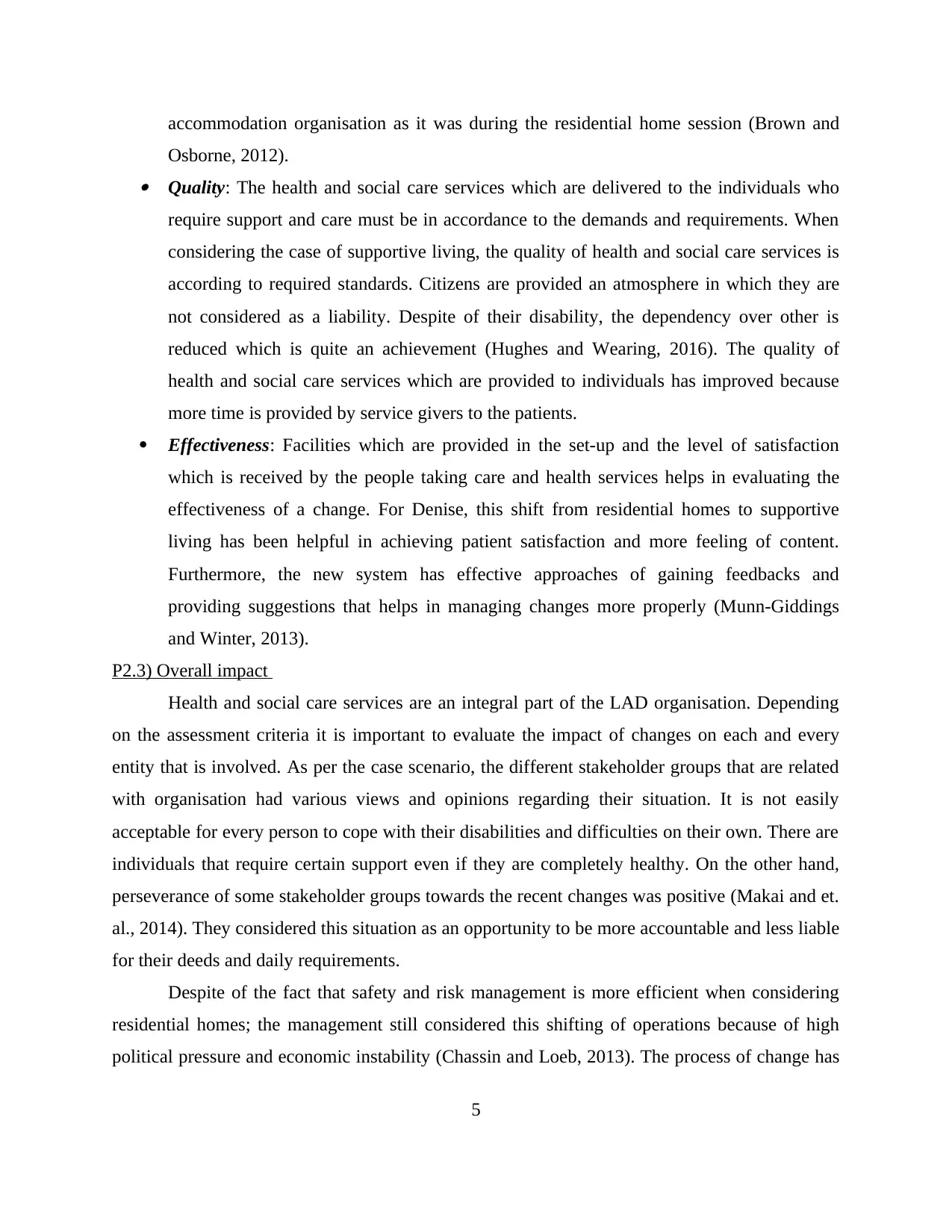
accommodation organisation as it was during the residential home session (Brown and
Osborne, 2012). Quality: The health and social care services which are delivered to the individuals who
require support and care must be in accordance to the demands and requirements. When
considering the case of supportive living, the quality of health and social care services is
according to required standards. Citizens are provided an atmosphere in which they are
not considered as a liability. Despite of their disability, the dependency over other is
reduced which is quite an achievement (Hughes and Wearing, 2016). The quality of
health and social care services which are provided to individuals has improved because
more time is provided by service givers to the patients.
Effectiveness: Facilities which are provided in the set-up and the level of satisfaction
which is received by the people taking care and health services helps in evaluating the
effectiveness of a change. For Denise, this shift from residential homes to supportive
living has been helpful in achieving patient satisfaction and more feeling of content.
Furthermore, the new system has effective approaches of gaining feedbacks and
providing suggestions that helps in managing changes more properly (Munn-Giddings
and Winter, 2013).
P2.3) Overall impact
Health and social care services are an integral part of the LAD organisation. Depending
on the assessment criteria it is important to evaluate the impact of changes on each and every
entity that is involved. As per the case scenario, the different stakeholder groups that are related
with organisation had various views and opinions regarding their situation. It is not easily
acceptable for every person to cope with their disabilities and difficulties on their own. There are
individuals that require certain support even if they are completely healthy. On the other hand,
perseverance of some stakeholder groups towards the recent changes was positive (Makai and et.
al., 2014). They considered this situation as an opportunity to be more accountable and less liable
for their deeds and daily requirements.
Despite of the fact that safety and risk management is more efficient when considering
residential homes; the management still considered this shifting of operations because of high
political pressure and economic instability (Chassin and Loeb, 2013). The process of change has
5
Osborne, 2012). Quality: The health and social care services which are delivered to the individuals who
require support and care must be in accordance to the demands and requirements. When
considering the case of supportive living, the quality of health and social care services is
according to required standards. Citizens are provided an atmosphere in which they are
not considered as a liability. Despite of their disability, the dependency over other is
reduced which is quite an achievement (Hughes and Wearing, 2016). The quality of
health and social care services which are provided to individuals has improved because
more time is provided by service givers to the patients.
Effectiveness: Facilities which are provided in the set-up and the level of satisfaction
which is received by the people taking care and health services helps in evaluating the
effectiveness of a change. For Denise, this shift from residential homes to supportive
living has been helpful in achieving patient satisfaction and more feeling of content.
Furthermore, the new system has effective approaches of gaining feedbacks and
providing suggestions that helps in managing changes more properly (Munn-Giddings
and Winter, 2013).
P2.3) Overall impact
Health and social care services are an integral part of the LAD organisation. Depending
on the assessment criteria it is important to evaluate the impact of changes on each and every
entity that is involved. As per the case scenario, the different stakeholder groups that are related
with organisation had various views and opinions regarding their situation. It is not easily
acceptable for every person to cope with their disabilities and difficulties on their own. There are
individuals that require certain support even if they are completely healthy. On the other hand,
perseverance of some stakeholder groups towards the recent changes was positive (Makai and et.
al., 2014). They considered this situation as an opportunity to be more accountable and less liable
for their deeds and daily requirements.
Despite of the fact that safety and risk management is more efficient when considering
residential homes; the management still considered this shifting of operations because of high
political pressure and economic instability (Chassin and Loeb, 2013). The process of change has
5
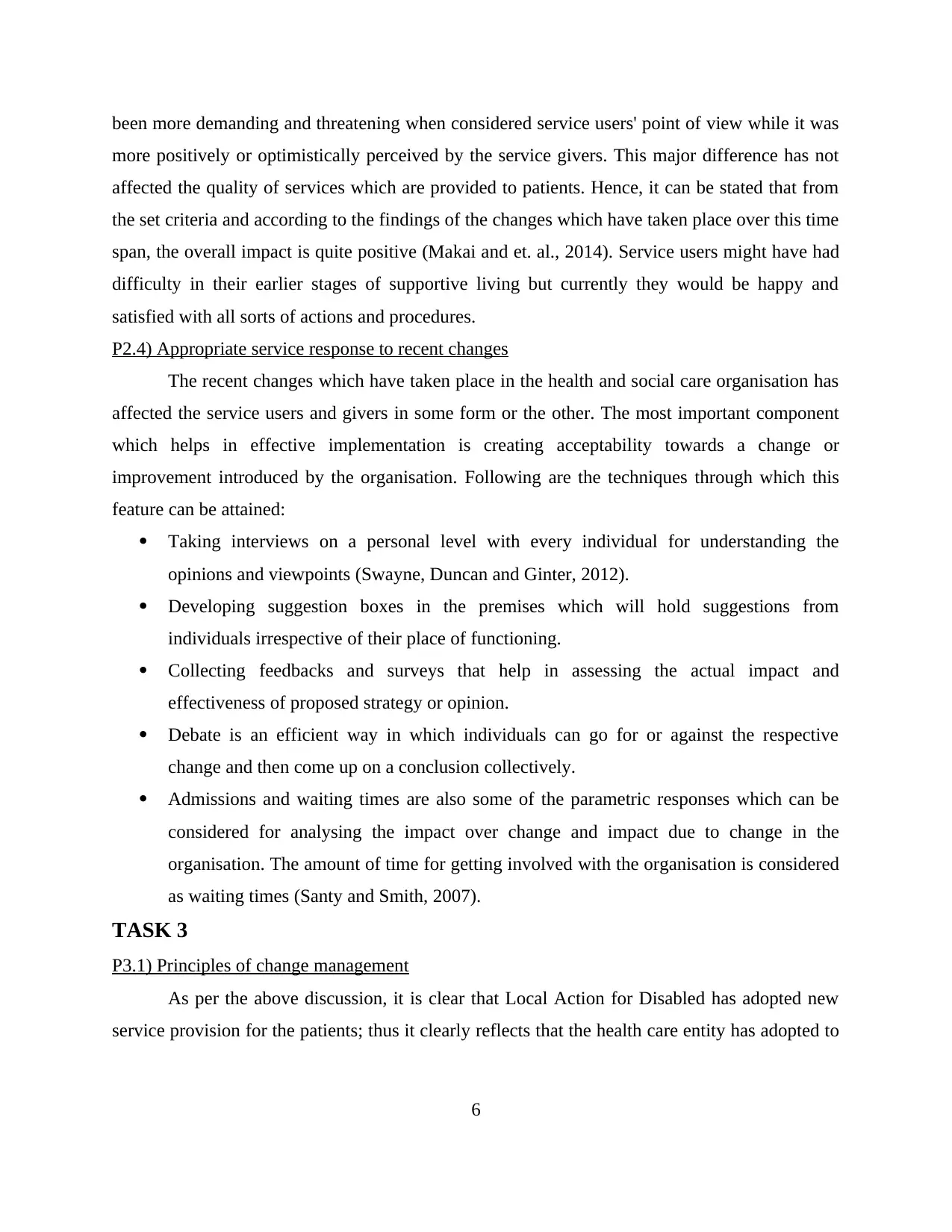
been more demanding and threatening when considered service users' point of view while it was
more positively or optimistically perceived by the service givers. This major difference has not
affected the quality of services which are provided to patients. Hence, it can be stated that from
the set criteria and according to the findings of the changes which have taken place over this time
span, the overall impact is quite positive (Makai and et. al., 2014). Service users might have had
difficulty in their earlier stages of supportive living but currently they would be happy and
satisfied with all sorts of actions and procedures.
P2.4) Appropriate service response to recent changes
The recent changes which have taken place in the health and social care organisation has
affected the service users and givers in some form or the other. The most important component
which helps in effective implementation is creating acceptability towards a change or
improvement introduced by the organisation. Following are the techniques through which this
feature can be attained:
Taking interviews on a personal level with every individual for understanding the
opinions and viewpoints (Swayne, Duncan and Ginter, 2012).
Developing suggestion boxes in the premises which will hold suggestions from
individuals irrespective of their place of functioning.
Collecting feedbacks and surveys that help in assessing the actual impact and
effectiveness of proposed strategy or opinion.
Debate is an efficient way in which individuals can go for or against the respective
change and then come up on a conclusion collectively.
Admissions and waiting times are also some of the parametric responses which can be
considered for analysing the impact over change and impact due to change in the
organisation. The amount of time for getting involved with the organisation is considered
as waiting times (Santy and Smith, 2007).
TASK 3
P3.1) Principles of change management
As per the above discussion, it is clear that Local Action for Disabled has adopted new
service provision for the patients; thus it clearly reflects that the health care entity has adopted to
6
more positively or optimistically perceived by the service givers. This major difference has not
affected the quality of services which are provided to patients. Hence, it can be stated that from
the set criteria and according to the findings of the changes which have taken place over this time
span, the overall impact is quite positive (Makai and et. al., 2014). Service users might have had
difficulty in their earlier stages of supportive living but currently they would be happy and
satisfied with all sorts of actions and procedures.
P2.4) Appropriate service response to recent changes
The recent changes which have taken place in the health and social care organisation has
affected the service users and givers in some form or the other. The most important component
which helps in effective implementation is creating acceptability towards a change or
improvement introduced by the organisation. Following are the techniques through which this
feature can be attained:
Taking interviews on a personal level with every individual for understanding the
opinions and viewpoints (Swayne, Duncan and Ginter, 2012).
Developing suggestion boxes in the premises which will hold suggestions from
individuals irrespective of their place of functioning.
Collecting feedbacks and surveys that help in assessing the actual impact and
effectiveness of proposed strategy or opinion.
Debate is an efficient way in which individuals can go for or against the respective
change and then come up on a conclusion collectively.
Admissions and waiting times are also some of the parametric responses which can be
considered for analysing the impact over change and impact due to change in the
organisation. The amount of time for getting involved with the organisation is considered
as waiting times (Santy and Smith, 2007).
TASK 3
P3.1) Principles of change management
As per the above discussion, it is clear that Local Action for Disabled has adopted new
service provision for the patients; thus it clearly reflects that the health care entity has adopted to
6
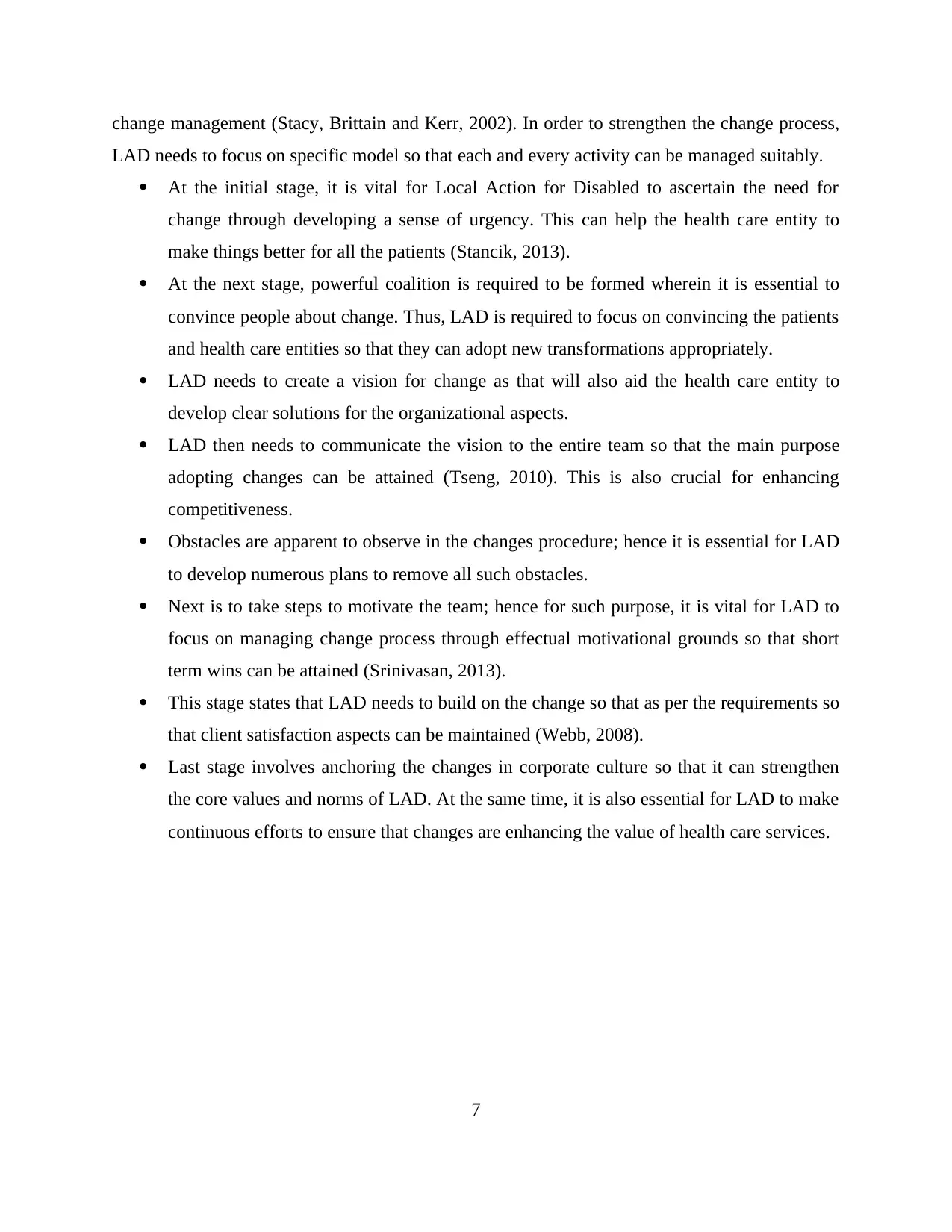
change management (Stacy, Brittain and Kerr, 2002). In order to strengthen the change process,
LAD needs to focus on specific model so that each and every activity can be managed suitably.
At the initial stage, it is vital for Local Action for Disabled to ascertain the need for
change through developing a sense of urgency. This can help the health care entity to
make things better for all the patients (Stancik, 2013).
At the next stage, powerful coalition is required to be formed wherein it is essential to
convince people about change. Thus, LAD is required to focus on convincing the patients
and health care entities so that they can adopt new transformations appropriately.
LAD needs to create a vision for change as that will also aid the health care entity to
develop clear solutions for the organizational aspects.
LAD then needs to communicate the vision to the entire team so that the main purpose
adopting changes can be attained (Tseng, 2010). This is also crucial for enhancing
competitiveness.
Obstacles are apparent to observe in the changes procedure; hence it is essential for LAD
to develop numerous plans to remove all such obstacles.
Next is to take steps to motivate the team; hence for such purpose, it is vital for LAD to
focus on managing change process through effectual motivational grounds so that short
term wins can be attained (Srinivasan, 2013).
This stage states that LAD needs to build on the change so that as per the requirements so
that client satisfaction aspects can be maintained (Webb, 2008).
Last stage involves anchoring the changes in corporate culture so that it can strengthen
the core values and norms of LAD. At the same time, it is also essential for LAD to make
continuous efforts to ensure that changes are enhancing the value of health care services.
7
LAD needs to focus on specific model so that each and every activity can be managed suitably.
At the initial stage, it is vital for Local Action for Disabled to ascertain the need for
change through developing a sense of urgency. This can help the health care entity to
make things better for all the patients (Stancik, 2013).
At the next stage, powerful coalition is required to be formed wherein it is essential to
convince people about change. Thus, LAD is required to focus on convincing the patients
and health care entities so that they can adopt new transformations appropriately.
LAD needs to create a vision for change as that will also aid the health care entity to
develop clear solutions for the organizational aspects.
LAD then needs to communicate the vision to the entire team so that the main purpose
adopting changes can be attained (Tseng, 2010). This is also crucial for enhancing
competitiveness.
Obstacles are apparent to observe in the changes procedure; hence it is essential for LAD
to develop numerous plans to remove all such obstacles.
Next is to take steps to motivate the team; hence for such purpose, it is vital for LAD to
focus on managing change process through effectual motivational grounds so that short
term wins can be attained (Srinivasan, 2013).
This stage states that LAD needs to build on the change so that as per the requirements so
that client satisfaction aspects can be maintained (Webb, 2008).
Last stage involves anchoring the changes in corporate culture so that it can strengthen
the core values and norms of LAD. At the same time, it is also essential for LAD to make
continuous efforts to ensure that changes are enhancing the value of health care services.
7
Paraphrase This Document
Need a fresh take? Get an instant paraphrase of this document with our AI Paraphraser
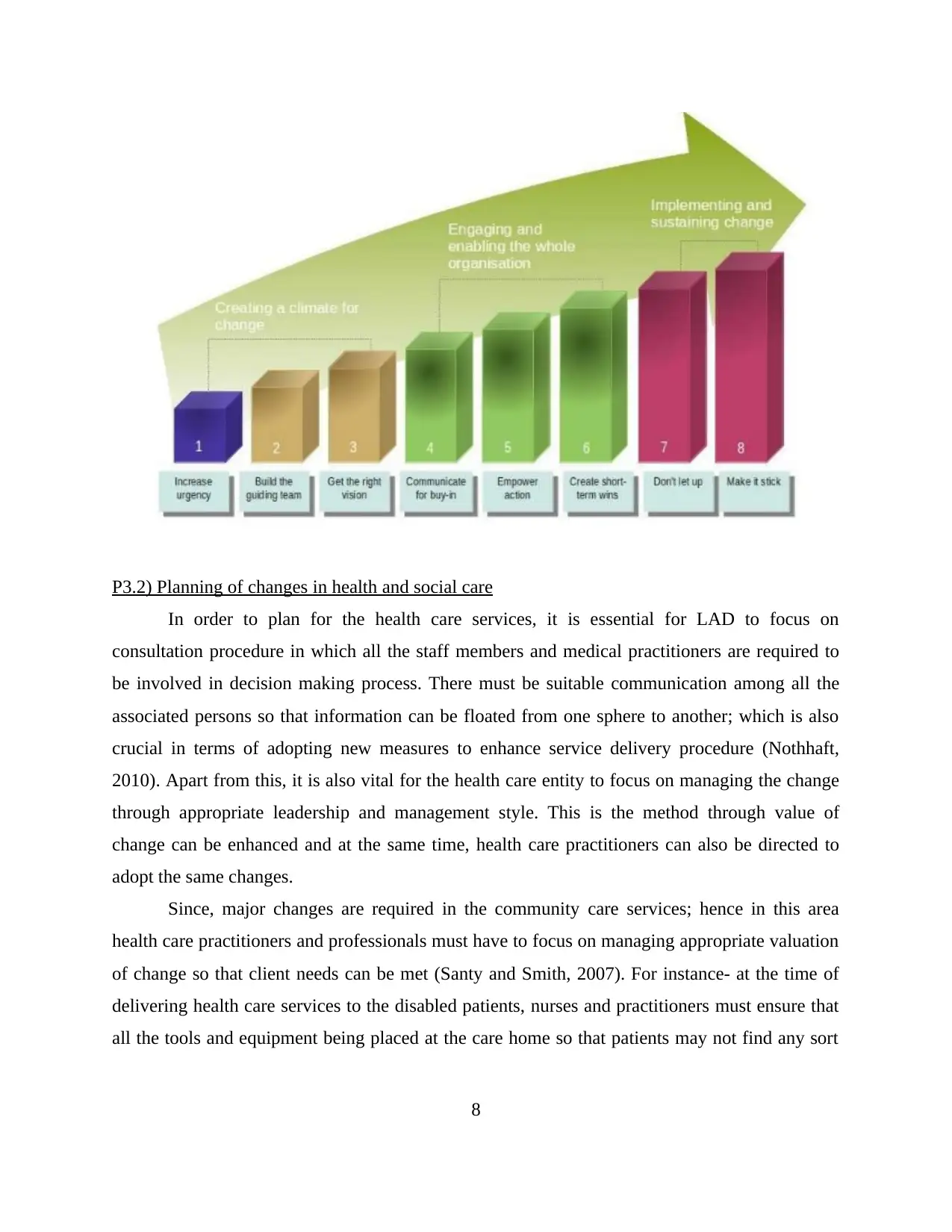
P3.2) Planning of changes in health and social care
In order to plan for the health care services, it is essential for LAD to focus on
consultation procedure in which all the staff members and medical practitioners are required to
be involved in decision making process. There must be suitable communication among all the
associated persons so that information can be floated from one sphere to another; which is also
crucial in terms of adopting new measures to enhance service delivery procedure (Nothhaft,
2010). Apart from this, it is also vital for the health care entity to focus on managing the change
through appropriate leadership and management style. This is the method through value of
change can be enhanced and at the same time, health care practitioners can also be directed to
adopt the same changes.
Since, major changes are required in the community care services; hence in this area
health care practitioners and professionals must have to focus on managing appropriate valuation
of change so that client needs can be met (Santy and Smith, 2007). For instance- at the time of
delivering health care services to the disabled patients, nurses and practitioners must ensure that
all the tools and equipment being placed at the care home so that patients may not find any sort
8
In order to plan for the health care services, it is essential for LAD to focus on
consultation procedure in which all the staff members and medical practitioners are required to
be involved in decision making process. There must be suitable communication among all the
associated persons so that information can be floated from one sphere to another; which is also
crucial in terms of adopting new measures to enhance service delivery procedure (Nothhaft,
2010). Apart from this, it is also vital for the health care entity to focus on managing the change
through appropriate leadership and management style. This is the method through value of
change can be enhanced and at the same time, health care practitioners can also be directed to
adopt the same changes.
Since, major changes are required in the community care services; hence in this area
health care practitioners and professionals must have to focus on managing appropriate valuation
of change so that client needs can be met (Santy and Smith, 2007). For instance- at the time of
delivering health care services to the disabled patients, nurses and practitioners must ensure that
all the tools and equipment being placed at the care home so that patients may not find any sort
8
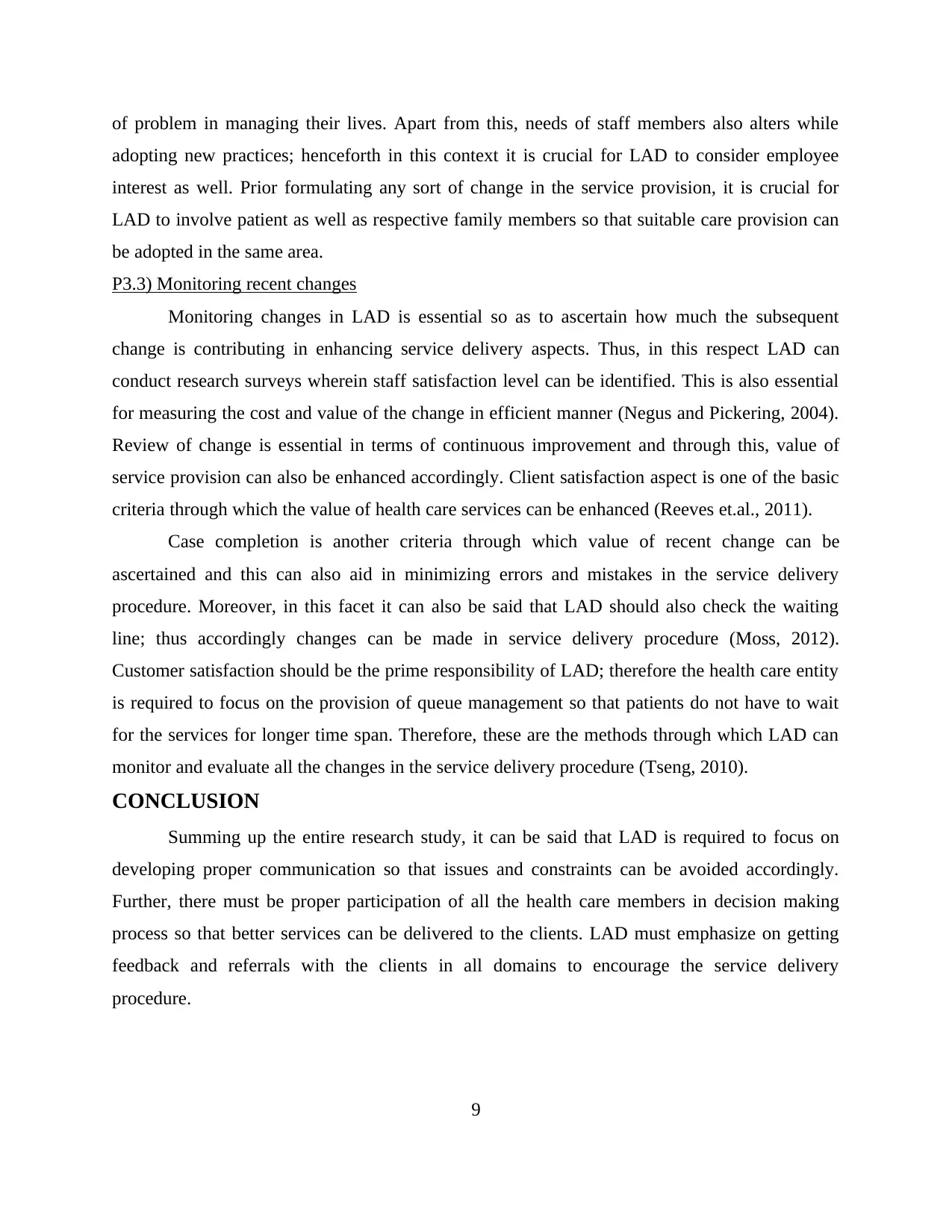
of problem in managing their lives. Apart from this, needs of staff members also alters while
adopting new practices; henceforth in this context it is crucial for LAD to consider employee
interest as well. Prior formulating any sort of change in the service provision, it is crucial for
LAD to involve patient as well as respective family members so that suitable care provision can
be adopted in the same area.
P3.3) Monitoring recent changes
Monitoring changes in LAD is essential so as to ascertain how much the subsequent
change is contributing in enhancing service delivery aspects. Thus, in this respect LAD can
conduct research surveys wherein staff satisfaction level can be identified. This is also essential
for measuring the cost and value of the change in efficient manner (Negus and Pickering, 2004).
Review of change is essential in terms of continuous improvement and through this, value of
service provision can also be enhanced accordingly. Client satisfaction aspect is one of the basic
criteria through which the value of health care services can be enhanced (Reeves et.al., 2011).
Case completion is another criteria through which value of recent change can be
ascertained and this can also aid in minimizing errors and mistakes in the service delivery
procedure. Moreover, in this facet it can also be said that LAD should also check the waiting
line; thus accordingly changes can be made in service delivery procedure (Moss, 2012).
Customer satisfaction should be the prime responsibility of LAD; therefore the health care entity
is required to focus on the provision of queue management so that patients do not have to wait
for the services for longer time span. Therefore, these are the methods through which LAD can
monitor and evaluate all the changes in the service delivery procedure (Tseng, 2010).
CONCLUSION
Summing up the entire research study, it can be said that LAD is required to focus on
developing proper communication so that issues and constraints can be avoided accordingly.
Further, there must be proper participation of all the health care members in decision making
process so that better services can be delivered to the clients. LAD must emphasize on getting
feedback and referrals with the clients in all domains to encourage the service delivery
procedure.
9
adopting new practices; henceforth in this context it is crucial for LAD to consider employee
interest as well. Prior formulating any sort of change in the service provision, it is crucial for
LAD to involve patient as well as respective family members so that suitable care provision can
be adopted in the same area.
P3.3) Monitoring recent changes
Monitoring changes in LAD is essential so as to ascertain how much the subsequent
change is contributing in enhancing service delivery aspects. Thus, in this respect LAD can
conduct research surveys wherein staff satisfaction level can be identified. This is also essential
for measuring the cost and value of the change in efficient manner (Negus and Pickering, 2004).
Review of change is essential in terms of continuous improvement and through this, value of
service provision can also be enhanced accordingly. Client satisfaction aspect is one of the basic
criteria through which the value of health care services can be enhanced (Reeves et.al., 2011).
Case completion is another criteria through which value of recent change can be
ascertained and this can also aid in minimizing errors and mistakes in the service delivery
procedure. Moreover, in this facet it can also be said that LAD should also check the waiting
line; thus accordingly changes can be made in service delivery procedure (Moss, 2012).
Customer satisfaction should be the prime responsibility of LAD; therefore the health care entity
is required to focus on the provision of queue management so that patients do not have to wait
for the services for longer time span. Therefore, these are the methods through which LAD can
monitor and evaluate all the changes in the service delivery procedure (Tseng, 2010).
CONCLUSION
Summing up the entire research study, it can be said that LAD is required to focus on
developing proper communication so that issues and constraints can be avoided accordingly.
Further, there must be proper participation of all the health care members in decision making
process so that better services can be delivered to the clients. LAD must emphasize on getting
feedback and referrals with the clients in all domains to encourage the service delivery
procedure.
9
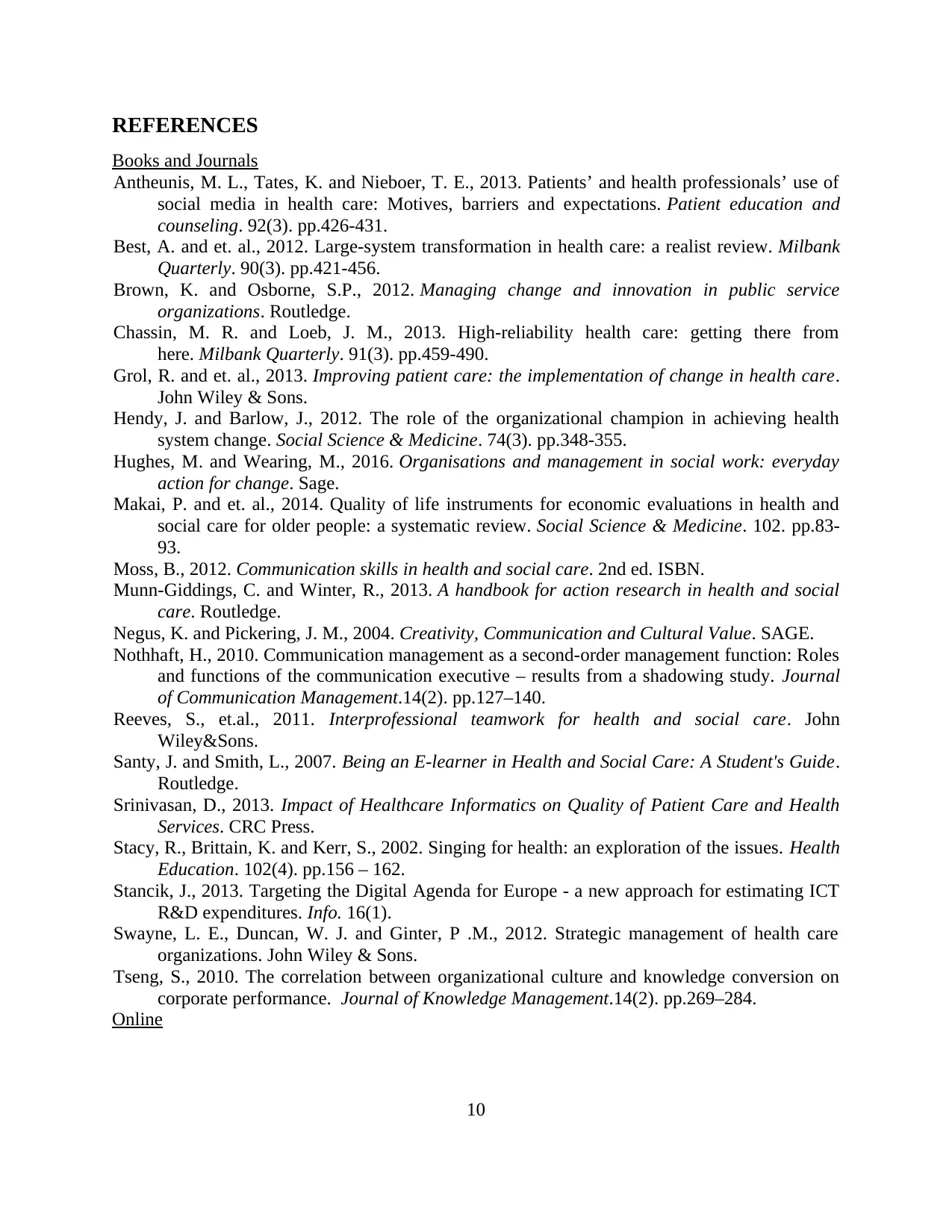
REFERENCES
Books and Journals
Antheunis, M. L., Tates, K. and Nieboer, T. E., 2013. Patients’ and health professionals’ use of
social media in health care: Motives, barriers and expectations. Patient education and
counseling. 92(3). pp.426-431.
Best, A. and et. al., 2012. Large‐system transformation in health care: a realist review. Milbank
Quarterly. 90(3). pp.421-456.
Brown, K. and Osborne, S.P., 2012. Managing change and innovation in public service
organizations. Routledge.
Chassin, M. R. and Loeb, J. M., 2013. High‐reliability health care: getting there from
here. Milbank Quarterly. 91(3). pp.459-490.
Grol, R. and et. al., 2013. Improving patient care: the implementation of change in health care.
John Wiley & Sons.
Hendy, J. and Barlow, J., 2012. The role of the organizational champion in achieving health
system change. Social Science & Medicine. 74(3). pp.348-355.
Hughes, M. and Wearing, M., 2016. Organisations and management in social work: everyday
action for change. Sage.
Makai, P. and et. al., 2014. Quality of life instruments for economic evaluations in health and
social care for older people: a systematic review. Social Science & Medicine. 102. pp.83-
93.
Moss, B., 2012. Communication skills in health and social care. 2nd ed. ISBN.
Munn-Giddings, C. and Winter, R., 2013. A handbook for action research in health and social
care. Routledge.
Negus, K. and Pickering, J. M., 2004. Creativity, Communication and Cultural Value. SAGE.
Nothhaft, H., 2010. Communication management as a second-order management function: Roles
and functions of the communication executive – results from a shadowing study. Journal
of Communication Management.14(2). pp.127–140.
Reeves, S., et.al., 2011. Interprofessional teamwork for health and social care. John
Wiley&Sons.
Santy, J. and Smith, L., 2007. Being an E-learner in Health and Social Care: A Student's Guide.
Routledge.
Srinivasan, D., 2013. Impact of Healthcare Informatics on Quality of Patient Care and Health
Services. CRC Press.
Stacy, R., Brittain, K. and Kerr, S., 2002. Singing for health: an exploration of the issues. Health
Education. 102(4). pp.156 – 162.
Stancik, J., 2013. Targeting the Digital Agenda for Europe - a new approach for estimating ICT
R&D expenditures. Info. 16(1).
Swayne, L. E., Duncan, W. J. and Ginter, P .M., 2012. Strategic management of health care
organizations. John Wiley & Sons.
Tseng, S., 2010. The correlation between organizational culture and knowledge conversion on
corporate performance. Journal of Knowledge Management.14(2). pp.269–284.
Online
10
Books and Journals
Antheunis, M. L., Tates, K. and Nieboer, T. E., 2013. Patients’ and health professionals’ use of
social media in health care: Motives, barriers and expectations. Patient education and
counseling. 92(3). pp.426-431.
Best, A. and et. al., 2012. Large‐system transformation in health care: a realist review. Milbank
Quarterly. 90(3). pp.421-456.
Brown, K. and Osborne, S.P., 2012. Managing change and innovation in public service
organizations. Routledge.
Chassin, M. R. and Loeb, J. M., 2013. High‐reliability health care: getting there from
here. Milbank Quarterly. 91(3). pp.459-490.
Grol, R. and et. al., 2013. Improving patient care: the implementation of change in health care.
John Wiley & Sons.
Hendy, J. and Barlow, J., 2012. The role of the organizational champion in achieving health
system change. Social Science & Medicine. 74(3). pp.348-355.
Hughes, M. and Wearing, M., 2016. Organisations and management in social work: everyday
action for change. Sage.
Makai, P. and et. al., 2014. Quality of life instruments for economic evaluations in health and
social care for older people: a systematic review. Social Science & Medicine. 102. pp.83-
93.
Moss, B., 2012. Communication skills in health and social care. 2nd ed. ISBN.
Munn-Giddings, C. and Winter, R., 2013. A handbook for action research in health and social
care. Routledge.
Negus, K. and Pickering, J. M., 2004. Creativity, Communication and Cultural Value. SAGE.
Nothhaft, H., 2010. Communication management as a second-order management function: Roles
and functions of the communication executive – results from a shadowing study. Journal
of Communication Management.14(2). pp.127–140.
Reeves, S., et.al., 2011. Interprofessional teamwork for health and social care. John
Wiley&Sons.
Santy, J. and Smith, L., 2007. Being an E-learner in Health and Social Care: A Student's Guide.
Routledge.
Srinivasan, D., 2013. Impact of Healthcare Informatics on Quality of Patient Care and Health
Services. CRC Press.
Stacy, R., Brittain, K. and Kerr, S., 2002. Singing for health: an exploration of the issues. Health
Education. 102(4). pp.156 – 162.
Stancik, J., 2013. Targeting the Digital Agenda for Europe - a new approach for estimating ICT
R&D expenditures. Info. 16(1).
Swayne, L. E., Duncan, W. J. and Ginter, P .M., 2012. Strategic management of health care
organizations. John Wiley & Sons.
Tseng, S., 2010. The correlation between organizational culture and knowledge conversion on
corporate performance. Journal of Knowledge Management.14(2). pp.269–284.
Online
10
Secure Best Marks with AI Grader
Need help grading? Try our AI Grader for instant feedback on your assignments.
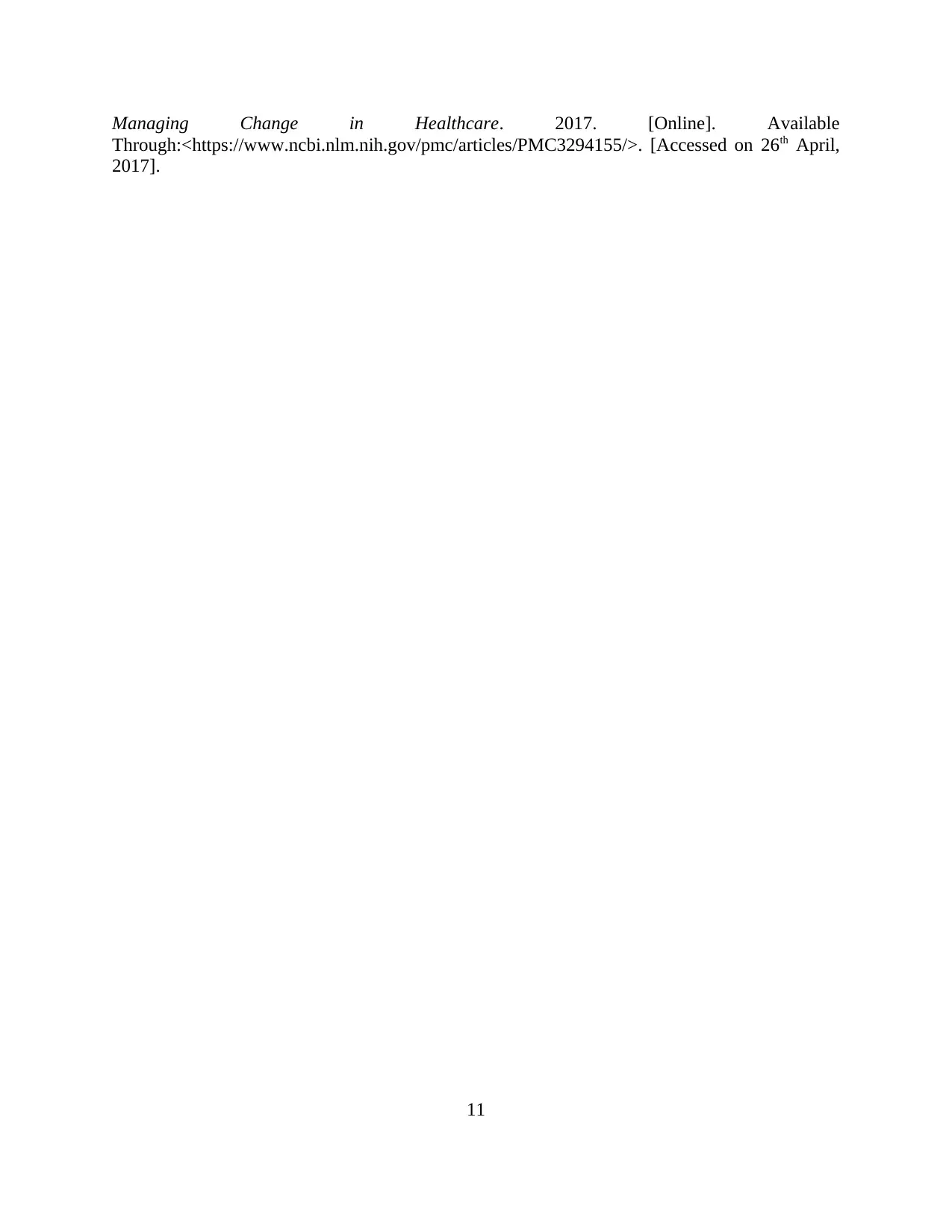
Managing Change in Healthcare. 2017. [Online]. Available
Through:<https://www.ncbi.nlm.nih.gov/pmc/articles/PMC3294155/>. [Accessed on 26th April,
2017].
11
Through:<https://www.ncbi.nlm.nih.gov/pmc/articles/PMC3294155/>. [Accessed on 26th April,
2017].
11
1 out of 11
Related Documents
Your All-in-One AI-Powered Toolkit for Academic Success.
+13062052269
info@desklib.com
Available 24*7 on WhatsApp / Email
![[object Object]](/_next/static/media/star-bottom.7253800d.svg)
Unlock your academic potential
© 2024 | Zucol Services PVT LTD | All rights reserved.





